Lifestyle
They transformed a sad, junk-filled yard into a DIY native plant wonderland

Water-hungry lawns are symbols of Los Angeles’ past. In this series, we spotlight yards with alternative, low-water landscaping built for the future.
At the top of a roller-coaster hill in Highland Park, Thomas Zamora and his husband, Raul Rojas, enjoy two spectacular views — of the Pasadena hills to the east and of the meandering expanse of native plants, succulents and vegetables in a backyard that once was nothing but dirt and junk cars.
It’s been an evolution of nearly a decade, say Zamora and Rojas, but today, their backyard boasts a deck rimmed with pots of colorful succulents and wide water-permeable paths of flagstone and river pebbles, lined with fragrant plantings of California native trees and flowering shrubs. There’s a raised bed full of vegetables, a potted lemon tree and a few red-blooming Australian grevilleas and South African leucadendron left over from the early days of their landscaping journey “because the hummingbirds love them so much,” Zamora said. “They fight over the flowers, so we couldn’t stand to take them out.”
But almost everything else in the backyard, along with the terraced planters out front and the parkway, is devoted to California native plants, a passion inspired by the Theodore Payne Foundation’s Native Plant Garden Tour in 2015, when the couple saw what beautiful gardens others had created from native perennials, shrubs and wildflowers.
An oasis of welcoming serenity in the backyard of Raul Rojas and Thomas Zamora’s Highland Park home.
“That started us on our journey of ‘Frankensteining’ our landscape,” Zamora said, laughing. “The tours helped us get ideas for what elements we thought would look great in our yard. It wasn’t a formal process, because we did things ourselves. We found things we wanted, and places to fit them in, and just sort of winged it.”
They winged it so well that their home is now a regular part of Theodore Payne’s Native Plant Garden Tour, being held on April 13 and 14 this year. (Tickets are sold out online, but at publication time were still available for purchase in person at the foundation’s office in Sun Valley, Tuesdays through Saturdays from 8:30 a.m. to 4:30 p.m. for $55 (children under 16 are free).
The couple’s garden is alive with bees, hummingbirds and other pollinators, and there are chairs and even a flower-shaded bench for visitors to sit and admire the view. The space exudes serenity and invites wanderers —and is clearly a labor of love for both Zamora and Rojas. “Every Sunday is garden day and we enjoy the process,” Rojas said. “It’s a place for exercise and meditation … our happy place. And who does the weeding? Us!”
On their tidy potting bench, a butter knife rests in a pot, at the ready to tackle any unwanted sprouts. “The best weeding tool is a butter knife,” Rojas says confidentially. “My grandma taught me that; you just jab the knife in at the base of the root and pull the weed up by pinching it between two fingers.”
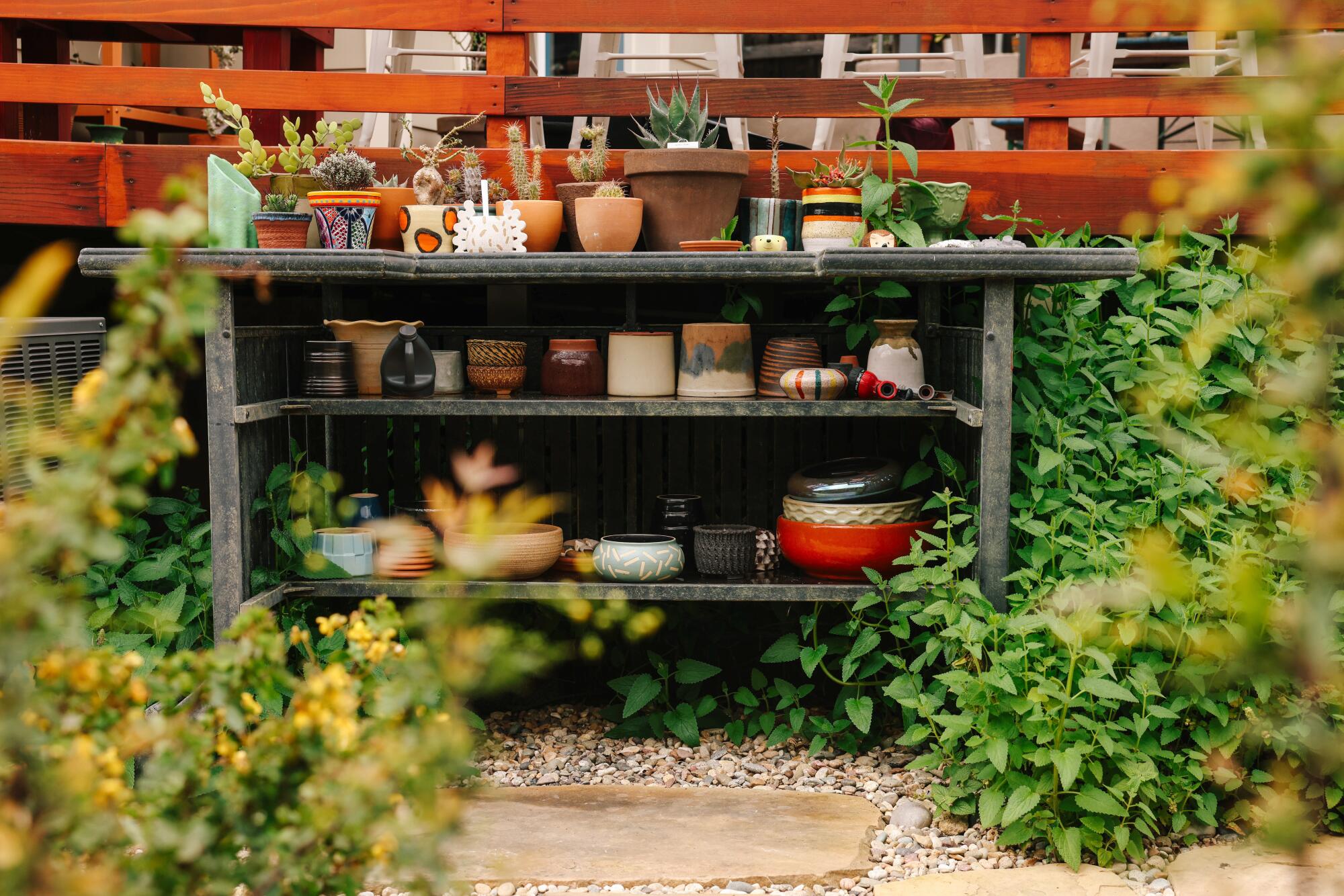
A relative’s discarded outdoor bar became the perfect potting bench for the couple’s backyard.
Clearly the technique works, because weeds — the bane of most gardens, including native plant landscapes — are visible nowhere in this yard. The plantings are jumbled but meticulous — almost Disney-esque — with brimming pots of succulents on the front porch and overflowing terraces of blue-blooming rosemary, a Mediterranean plant, along with native plants like evergreen currant (Ribes viburnifolium), island alum root (Heuchera maxima), fragrant blue pitcher sage (Lepechinia fragrans), bush sunflowers (Encelia californica) and island buckwheat hybrid (Eriogonum x blissianum)
It all looks perfect, down to the beautiful tangle of poppies and other native wildflowers in the narrow strip of parkway. But the process offered plenty of challenges, Zamora and Rojas said. “We’ve learned a lot along the way,” Rojas said.
Both men are California natives whose families enjoyed gardening and being outdoors, but they grew up around more traditional plants like roses, fruit trees and succulents. Plus, Rojas laughed, his parents kept him busy pulling weeds as a child.
When Zamora, an art department coordinator for TV shows like “No Good Deed,” bought the 1923 bungalow in 2009, the smallish backyard was filled with hard dirt and three junk cars, which thankfully were removed before he moved in in 2010. In the beginning, before he met Rojas, he focused more on the interior of the house and dabbled at planting just a few flower beds outside. He said his focus then was on showy drought-tolerant plants like statice and Pride of Madeira, a fast-growing perennial with giant purple blooms native to the Portuguese island of Madeira.
1

2
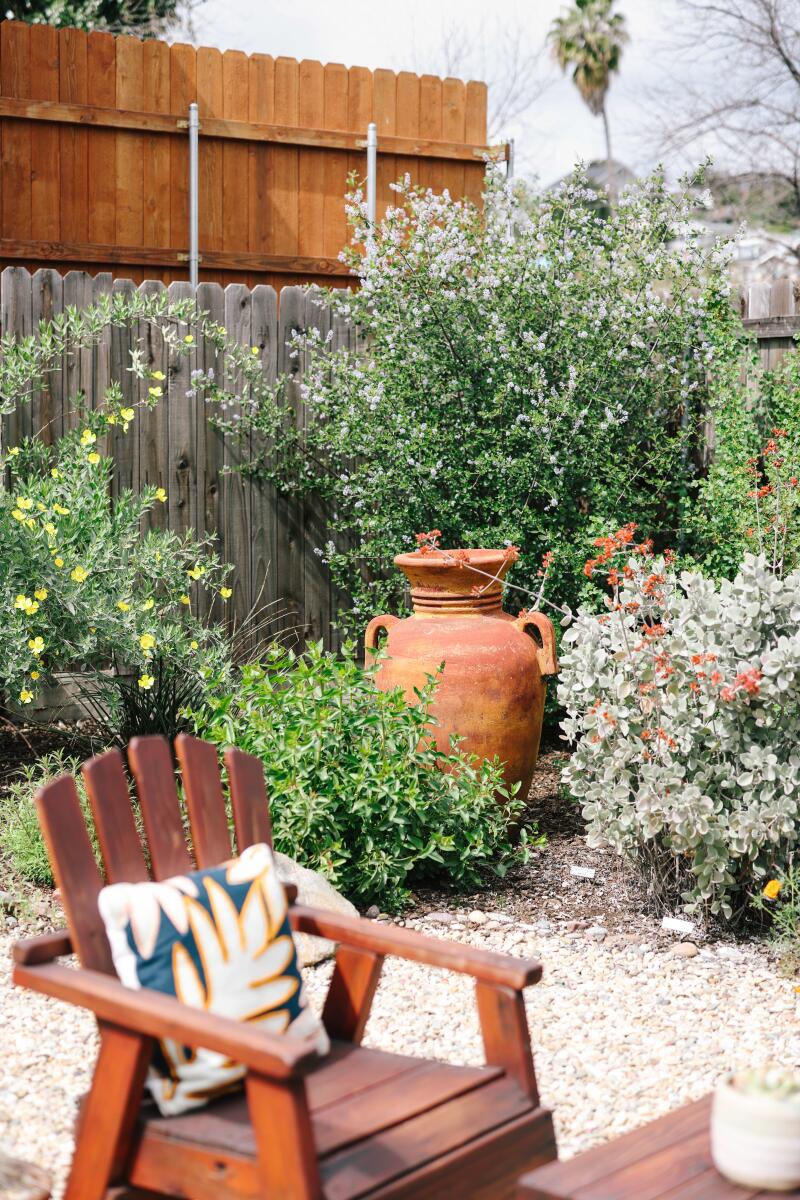
1. A leucadendron “Jester” from South Africa grows against a neighbor’s garage wall, against an artistic display of paint cans. The leucadendron is a holdover from Zamora’s earliest landscaping attempts, kept because it’s so popular with the hummingbirds. 2. (Dania Maxwell/Los Angeles Times)
“I didn’t realize these plants are invasive along the central coast,” he said. “I was just planting things because they looked pretty, and I knew they would grow because I’d seen them in other places.”
He added the leucadendron and grevillea for their showstopping, drought-tolerant blooms. But he also planted a white sage (Salvia apiana) because he admired the silvery green foliage of one of Southern California’s most famous indigenous plants during a local hike.
After Rojas moved in in 2012, the couple got more serious about the yard, visiting plant stores and nurseries to get ideas. In 2015, during a visit to Potted in Atwater Village, they saw a flier for the Theodore Payne tour and decided to give it try. It was easy to buy tickets for the tour in those days, Rojas said — “They didn’t sell out like they do today” — and the gardens they saw finally gave their landscaping a sharp focus: native plants.
“It was one of the best decisions we ever made,” Zamora said.
But once they started adding native plants in earnest, the challenges started. They amended their heavy clay soil with compost and other additives, something you would normally do to plant traditional landscape ornamentals and food. But after many of the new plants died, they learned their yard had mostly heavy, slow-draining clay soil, and that native plants prefer well-draining native soils over enriched garden plots.
“I learned that from one of Theodore Payne’s ‘Right Plant, Right Place’ classes that teaches you what plants do best in your situation,” Zamora said. “And I also used Calscape to find out if the plants I’m interested in will tolerate clay soils. That’s how we figured out a plan for adding plants we would love to have but don’t have a place where they will work.”
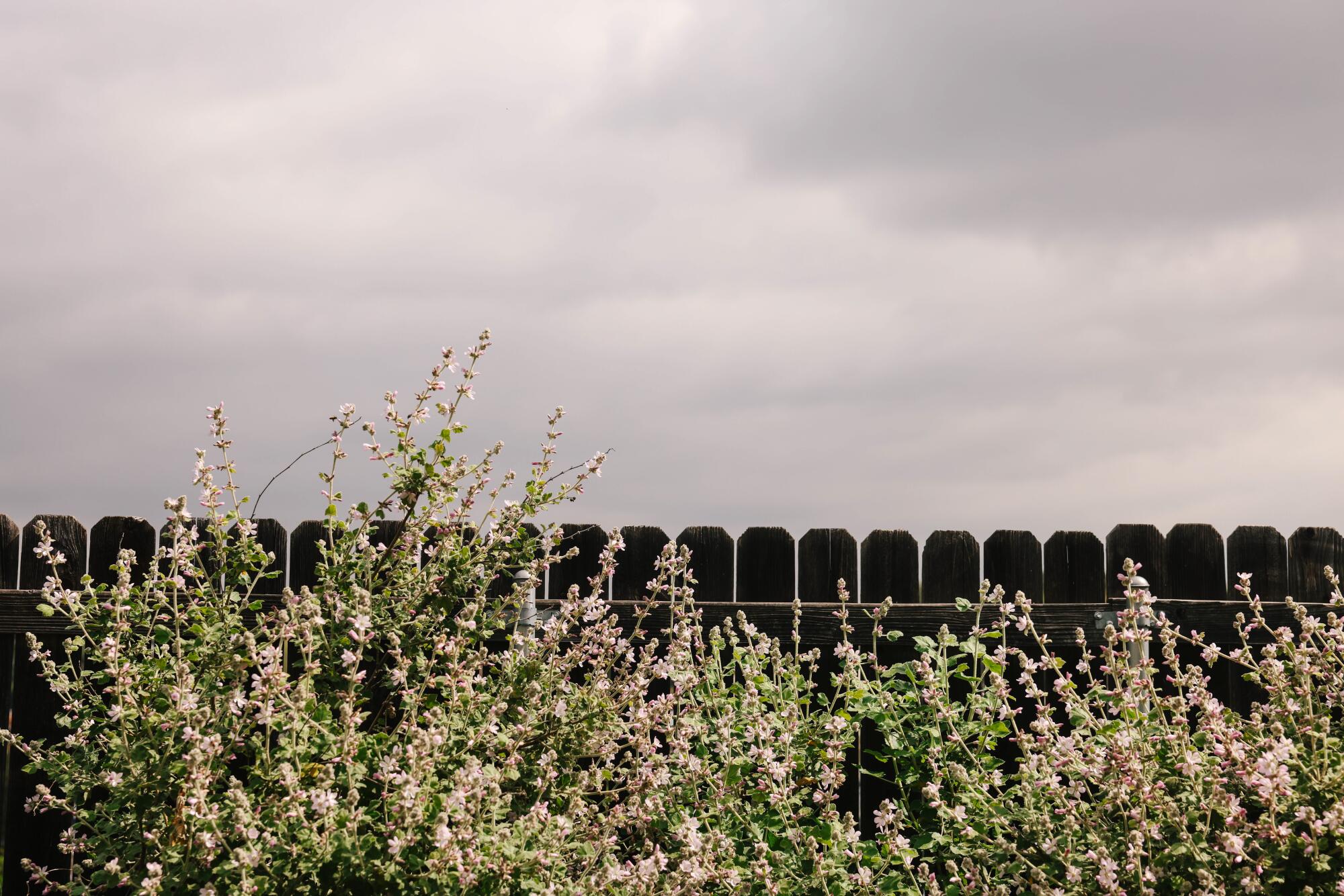
A San Clemente Island bushmallow loaded with pink blooms was planted from a one-gallon container and now grows exuberantly along the east fence of Raul Rojas and Thomas Zamora’s backyard.
They grow plants that don’t like clay in pots, such as the super-sweet smelling woolly bluecurls (Trichostema lanatum) near their side door; once established, it’s easily killed by too much water. The white sage has thrived, along with a very happy San Clemente Island bushmallow (Malacothamnus clementinus) that has grown from a one-gallon container to a massive shrub covered with blooms along their east fence.
They never really had a formal design, Zamora said. They tried things, and if it didn’t work, they tried something else. Initially they added two raised beds for vegetables but eventually removed one to create more space for paths and native plantings.
Adding pebble walkways helped solve problems with runoff and standing water in the backyard. “We do not have a bioswale [to capture rainwater until it drains into the soil] — I wish I had known about those when I was doing the walks,” Zamora said. “But I leveled the area so the water doesn’t pool now, and the rocks seem to help hold water so it doesn’t run off; it just seeps into the ground through the pavers.”
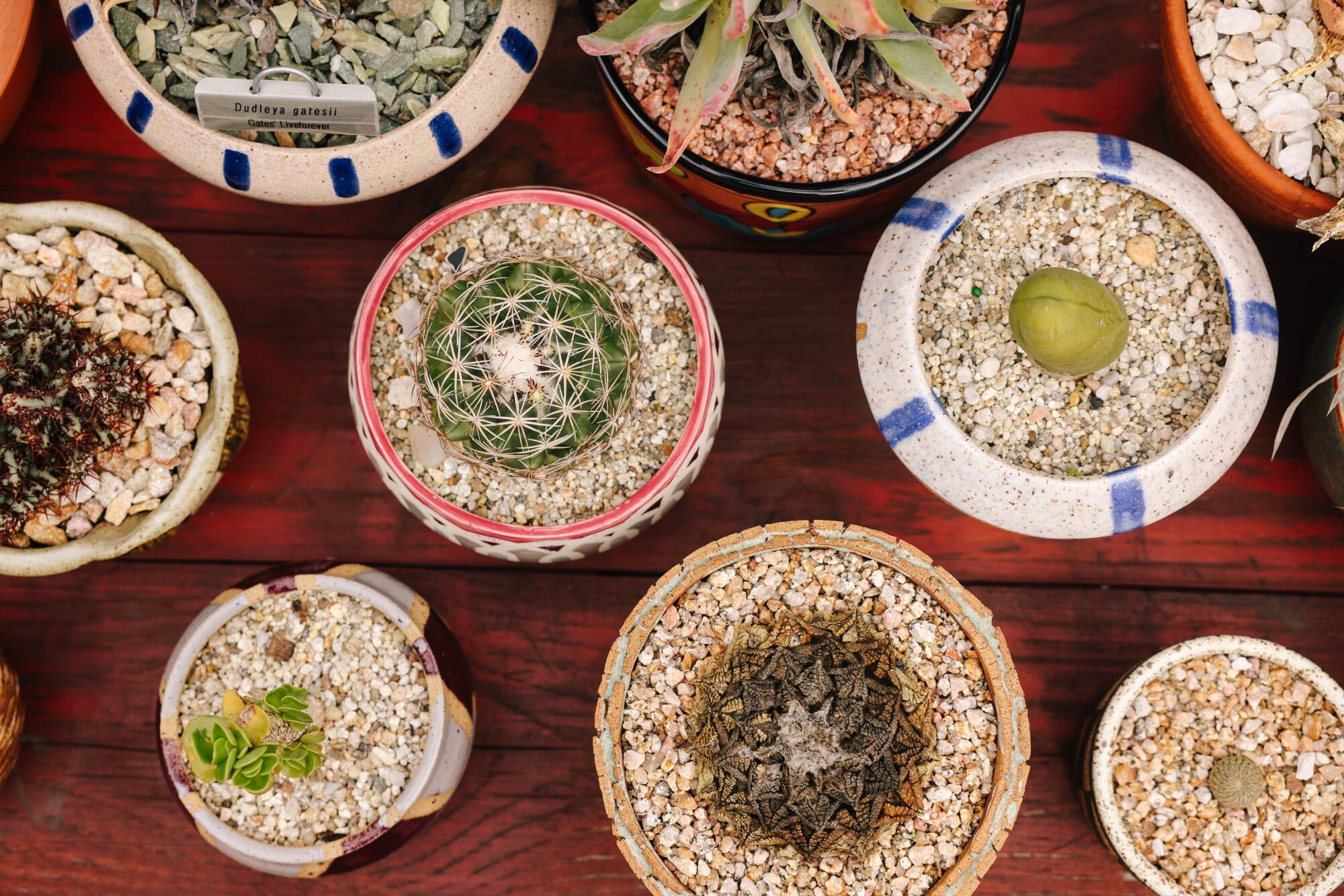
Succulents in colorful pots line the deck, front porch and potting bench at the home of Raul Rojas and Thomas Zamora.
Another helpful resource has been regular visits to the California Botanic Garden in Claremont, the state’s largest botanic garden devoted entirely to native plants. “It’s a peaceful place and very inspiring to see plants in their habitat,” Zamora said. “We went there lots during the pandemic because it was such a great place to walk around.”
They’re also regular customers of Hardy Californians, a pop-up native plant nursery in Sierra Madre. Rojas, an entertainment publicist, even volunteered there during the Hollywood actors’ strike in 2023, and came away an even bigger convert to the versatility and beauty of native plants.
“Our neighbors have been very positive,” Rojas said. “We got little signs for all the plants because people on neighborhood walks always ask us what we’ve planted, and what we recommend for a specific situation.”
A large ficus tree in the parkway outside their front door has died, probably because of damage when the street was dug up for water-pipe repairs. It’s a city-owned tree, Zamora said, so a city crew will have to remove it, “but we’re definitely going to talk to them about replacing it with something native.”
Over the years, they’ve gotten much more sanguine about the circle of life in their garden. “We’ve learned that gardening is a process and some plants do better than others,” Rojas said. “We used to get so upset — ‘OMG, this died!’ — but at this point, it’s more like, ‘Oh, this didn’t like that location.’ Now we see it as just a new planting opportunity.”
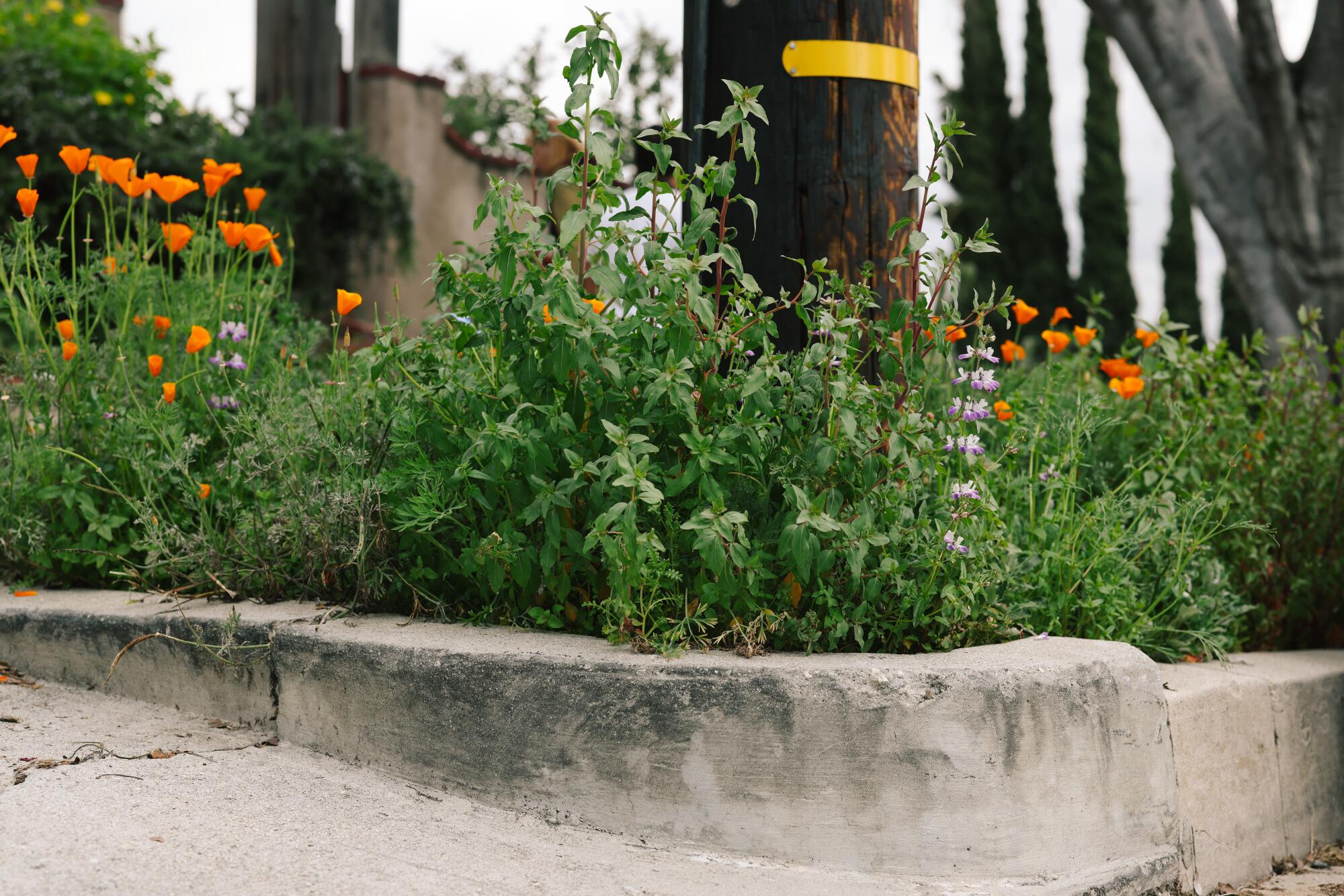
California poppies (Eschscholzia californica), purple Chinese houses (Collinsia heterophylla), baby blue eyes
(Nemophila menziesii) and other wildflowers grow thickly in the narrow parkway outside their home.

Lifestyle
'Wait Wait' for July 27, 2024: With Not My Job guest Kathleen Hanna

Kathleen Hanna of The Julie Ruin performs onstage at the 2016 Panorama NYC Festival – Day 2 at Randall’s Island on July 23, 2016 in New York City. (Photo by Nicholas Hunt/Getty Images)
Nicholas Hunt/Getty Images/Getty Images North America
hide caption
toggle caption
Nicholas Hunt/Getty Images/Getty Images North America
This week’s show was recorded in Chicago with host Peter Sagal, judge and scorekeeper Bill Kurtis, Not My Job guest Kathleen Hanna and panelists Meredith Scardino, Peter Grosz, and Mo Rocca Click the audio link above to hear the whole show.
Who’s Bill This Time
Momala Takes Over; Assigned Seats Are Back; And The Heat Is On
The Olympic Torch Reporch
Our Summer Olympics Preview
Bluff The Listener
Our panelists tell three stories about someone committing an office faux pas, only one of which is true.
Not My Job: We quiz Bikini Kill’s Kathleen Hanna on Hanna-Barbera
Punk icon Kathleen Hanna plays our game called, “Kathleen Hanna Meet Hannah-Barbera.” Three questions about the animation studio.
Panel Questions
Hide Your Receipts; VR Meets ER; Avocado Apologies
Limericks
Bill Kurtis reads three news-related limericks: Situation Room Cocktails; Burrito Bird; Hopped Up Sharks
Lightning Fill In The Blank
All the news we couldn’t fit anywhere else
Predictions
Our panelists predict what will be the big story out of the Paris Olympic Games
Lifestyle
L.A. Affairs: At 77, I had a crush on my best friend’s widower. Did he feel the same way?
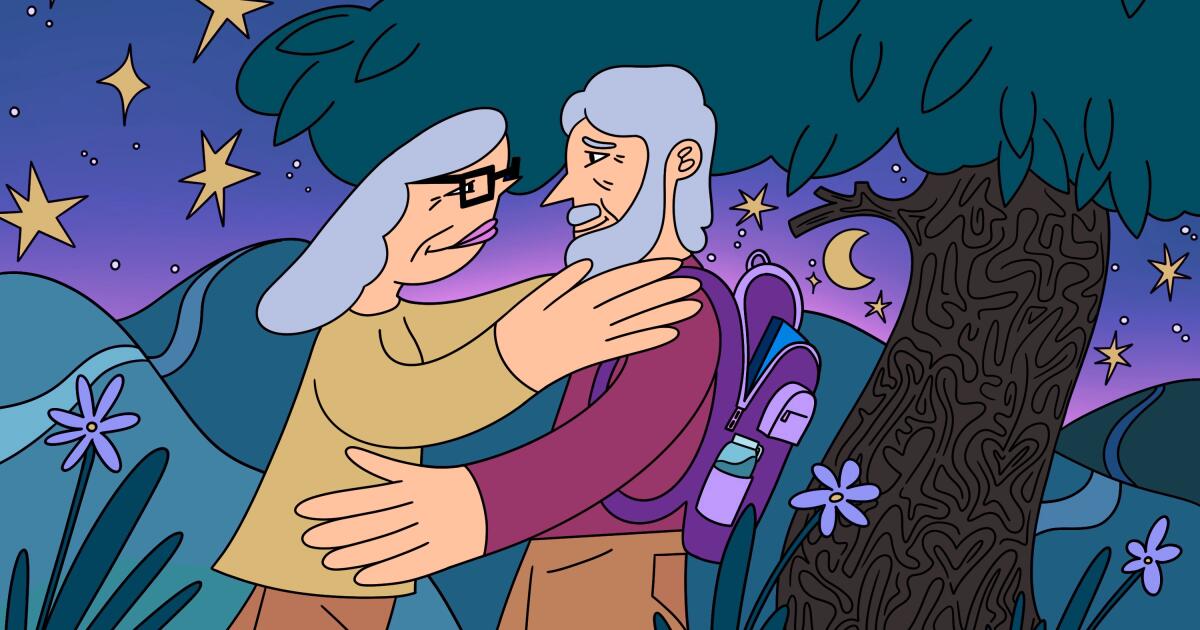
At 77, I had given up. After two failed marriages and years of unsuccessful dating, I accepted what seemed to be my fate: single for almost 40 years and single for however many remained. You don’t get it all, I told myself. I was grateful for family, friends and work. Life settled into what felt like order.
Until Ty.
As the husband of my best friend, he was no stranger, but he was usually peripheral. Then 10 years ago, my friend got lung cancer. I watched during visits, stunned at how nurturing Ty could be, taking care of her even though they had separated years before at her request.
After she died, Ty and I stayed in touch sporadically: a surprise sharing of his second granddaughter a year after we scattered my friend’s ashes, an invitation to the launch of my book a year later. Ty attended, hovering in the back, emerging after everyone left to attentively help load my car.
Two more years passed. During quiet moments, I remembered his sweetness. I also remembered his handsome face and long, tall body. Confused about what I wanted, I texted Ty, who’s an architect, under the guise of purchasing a tree for my backyard.
We spent an afternoon at the nursery, laughing, comparing options and agreeing on a final selection. When the tree arrived, I emailed a photo. He emailed a thank you.
Another three years passed, broken only by news of his third granddaughter and my memories of how good it felt to be with him. Alert to his attentiveness, but unsettled by both his remove and my growing interest, I risked reaching out again, this time about remodeling my garage.
Ty spent several hours at my house making measurements, checking the foundation and sharing pictures of his home in Topanga. His sketches for the garage arrived two weeks later via email.
I was grateful for his help but unsure over what sort of friendship we were developing, at least from his point of view. I, however, was clear. I wanted him to wrap his long arms around me, tell me sweet things and make me his.
Instead, I sent a gift card to a Topanga restaurant to thank him for his drawings.
“Maybe we should spend it together,” he texted.
We dined in the dusk of late summer. Our talk was easy. Discomfort lay in the unspoken. Anxious for clarity, I repeatedly let my hand linger near the candle flickering in the middle of our table. It remained untouched.
And that was as far as I was willing to go. I refused to be any more forward, having already compromised myself beyond my comfort level with what seemed, at least to me, embarrassingly transparent efforts to indicate my interest. Not making the first move was very important. If a man could not reach out, if he didn’t have the self-confidence to take the first step, he would not, I adamantly felt, be a good partner for me.
Two weeks later, Ty did email, suggesting an early evening hike in Tuna Canyon in Malibu. The setting was perfect. Sun sparkled off the ocean. A gentle breeze blew. We climbed uphill for sweeping coastal vistas and circled down to the shade of live oaks, touching only when he took my hand to steady me where the path was slippery. At the end of the trail, overlooking the juncture between the mountains and the sea, we stood opposite each other and talked animatedly for almost an hour, both of us reluctant to part.
Our conversation was engaging, but my inner dialogue was louder. When, I kept thinking, is this man going to suggest we continue the evening over dinner? We didn’t have to go out. We could eat at his house. It was 7 p.m., for God’s sake. Passing hikers even stopped to remark on our matching white hair and how well they thought we looked together. It was like a movie scene where the audience is yelling, “Kiss her, kiss her,” rooting for what they know is going to happen while the tension becomes almost unbearable. But bear it I did.
Each of us ate alone.
A few weeks later, at his suggestion, we were back at Tuna Canyon. This time Ty did invite me to end the evening at his house. Sitting close on his couch, but not too close, we drifted toward each other in the darkening room. His shoulder brushed mine reaching for his cup of coffee. My hip pressed his as I leaned in for my tea. Slowly, sharing wishes and hopes for our remaining years, we became shadows in the light of the moon. And in that darkness, in that illuminated space, he reached out.
This reticent man, this man who was so slow to move toward me, this sensitive man who hid himself behind layers so opaque I was unsure of his interest, released all that he had inside him.
“I wanted you,” Ty repeated again and again. “I was afraid of ruining things. You were her best friend. I didn’t want to lose your friendship.”
Our pent-up tension exploded.
Stunned and thrilled, I leaned into the space he opened.
Three years later, it is a space we continue to share: a place where neither of us has given up, a place where he wraps me in his long arms, a place we hold carefully against our diminishing days.
The author is the owner of a preschool in Venice as well as a psychotherapist, photographer and writer. Her first book, “Naked in the Woods: My Unexpected Years in a Hippie Commune,” was published in 2015. Her newest manuscript, “Bargains: A Coming of Aging Memoir Told in Tales,” is seeking a publisher. She lives in Mar Vista and can be found at margaretgrundstein.com, Instagram @margwla, Medium @margaretgrundstein and Substack @mgrundstein.
L.A. Affairs chronicles the search for romantic love in all its glorious expressions in the L.A. area, and we want to hear your true story. We pay $400 for a published essay. Email LAAffairs@latimes.com. You can find submission guidelines here. You can find past columns here.
Lifestyle
'Deadpool & Wolverine' is a self-cannibalizing slog
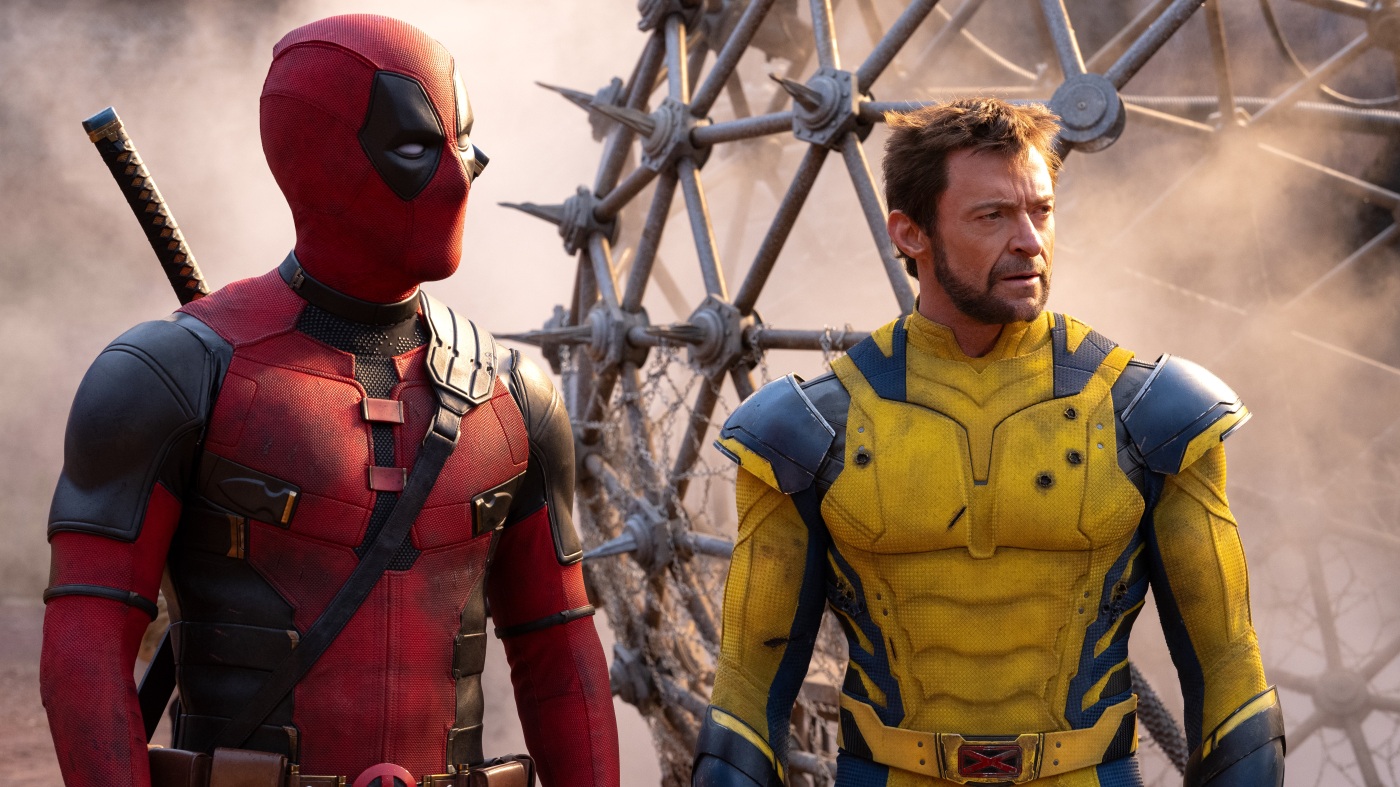
Ryan Reynolds stars as Deadpool and Hugh Jackman as Wolverine in an odd-couple action hero pairing.
Jay Maidment/20th Century Studios
hide caption
toggle caption
Jay Maidment/20th Century Studios
When Fox Studios released the first Deadpool movie back in 2016, it played like an irreverently funny antidote to our collective comic-book-movie fatigue. Wade Wilson, or Deadpool, was a foul-mouthed mercenary who obliterated his enemies and the fourth wall with the same gonzo energy.
Again and again, Deadpool turned to the camera and mocked the clichés of the superhero movie with such deadpan wit, you almost forgot you were watching a superhero movie. And Ryan Reynolds, Hollywood’s snarkiest leading man, might have been engineered in a lab to play this vulgar vigilante. I liked the movie well enough, though one was plenty; by the time Deadpool 2 rolled around in 2018, all that self-aware humor had started to seem awfully self-satisfied.
Now we have a third movie, Deadpool & Wolverine, which came about through some recent movie-industry machinations. When Disney bought Fox a few years ago, Deadpool, along with other mutant characters from the X-Men series, officially joined the franchise juggernaut known as the Marvel Cinematic Universe.
That puts the new movie in an almost interesting bind. It tries to poke fun at its tortured corporate parentage; one of the first things Deadpool says is “Marvel’s so stupid.” But now the movie also has to fit into the narrative parameters of the MCU. It tries to have it both ways: brand extension disguised as a satire of brand extension.

It’s also an odd-couple comedy, pairing Deadpool with the most famous of the X-Men: Logan, or Wolverine, the mutant with the unbreakable bones and the retractable metal claws, played as ever by a bulked-up Hugh Jackman.
The combo makes sense, and not just because both characters are Canadian. In earlier movies, Deadpool often made Wolverine the off-screen butt of his jokes. Both Deadpool and Wolverine are essentially immortal, their bodies capable of self-regenerating after being wounded. Both are tormented by past failures and are trying to redeem themselves. Onscreen, the two have a good, thorny chemistry, with Jackman’s brooding silences contrasting nicely with Reynolds’ mile-a-minute delivery.
I could tell you more about the story, but only at the risk of incurring the wrath of studio publicists who have asked critics not to discuss the plot or the movie’s many, many cameos. Let’s just say that the director Shawn Levy and his army of screenwriters bring the two leads together through various rifts in the multiverse. Yes, the multiverse, that ever-elastic comic-book conceit, with numerous Deadpools and Wolverines from various alternate realities popping up along the way.

I suppose it’s safe to mention that Matthew Macfadyen, lately of Succession, plays some kind of sinister multiverse bureaucrat, while Emma Corrin, of The Crown, plays a nasty villain in exile. It’s all thin, derivative stuff, and the script’s various wink-wink nods to other shows and movies, from Back to the Future to Furiosa to The Great British Bake Off, don’t make it feel much fresher. And Levy, who previously directed Reynolds in the sci-fi comedies Free Guy and The Adam Project, doesn’t have much feel for the splattery violence that is a staple of the Deadpool movies. There’s more tedium than excitement in the characters’ bone-crunching, crotch-stabbing killing sprees, complete with corn-syrupy geysers of blood.

For all its carnage, its strenuous meta-humor and an R-rated sensibility that tests the generally PG-13 confines of the MCU, Deadpool & Wolverine does strive for sincerity at times. Some of its cameos and plot turns are clearly designed to pay tribute to Fox’s X-Men films from the early 2000s.
As a longtime X-Men fan myself, I’m not entirely immune to the charms of this approach; there’s one casting choice, in particular, that made me smile, almost in spite of myself. It’s not enough to make the movie feel like less of a self-cannibalizing slog, though I suspect that many in the audience, who live for this kind of glib fan service, won’t mind. Say what you will about Marvel — I certainly have — but it isn’t nearly as stupid as Deadpool says it is.

-

 World1 week ago
World1 week agoOne dead after car crashes into restaurant in Paris
-

 Midwest1 week ago
Midwest1 week agoMichigan rep posts video response to Stephen Colbert's joke about his RNC speech: 'Touché'
-

 News1 week ago
News1 week agoVideo: Young Republicans on Why Their Party Isn’t Reaching Gen Z (And What They Can Do About It)
-

 Movie Reviews1 week ago
Movie Reviews1 week agoMovie Review: A new generation drives into the storm in rousing ‘Twisters’
-

 News1 week ago
News1 week agoIn Milwaukee, Black Voters Struggle to Find a Home With Either Party
-

 Politics1 week ago
Politics1 week agoFox News Politics: The Call is Coming from Inside the House
-

 News1 week ago
News1 week agoVideo: J.D. Vance Accepts Vice-Presidential Nomination
-

 World1 week ago
World1 week agoTrump to take RNC stage for first speech since assassination attempt















